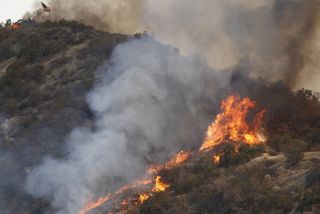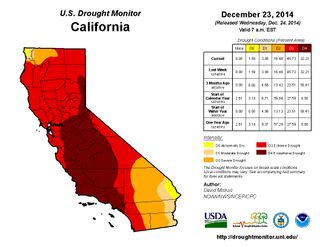California Droughts Could Have Dangerous Ripple Effects

Epic droughts like the one gripping California for three years now may become more frequent in the future due to climate change, according to new research.
This will not only strain the drinking-water supplies for California's 38 million people, but will also induce a cascade of other hazards — including fires, floods and poor water quality — as populations continue to grow statewide, scientists say.
Despite heavy rains this month, 78 percent of California is still experiencing either exceptional or extreme drought, according to the National Drought Mitigation Center. Unusually low snowfall across the state is largely to blame, scientists say. About one-third of California's water comes from snowmelt in the Sierra Nevada mountains, which stretch through the eastern part of the state for nearly 400 miles (644 kilometers).
"All this rain is great," Nina Oakley, a scientist with the Desert Research Institute in Nevada, told Live Science at the annual American Geophysical Union meeting earlier this month. "But really, the snow in the Sierra is what we are after for a good year to help bring us out of drought." [Video: California Drought Map Time-Lapse Shows Distressing Trend]
In April 2014, when the year's snowpack should have been at its peak, the California Department of Water Resources reported that levels were at only 18 percent of the average for that time of the year. One of the reasons snowpack was so low this year, Oakley said, was that California's winter temperatures have been increasing in recent years, resulting in less snow and earlier melting times in the spring.
This trend toward less snowpack is projected to continue this century as some climate models suggest that minimum winter temperatures will continue to increase across the state, Oakley said.
"And as we continue to have warmer temperatures and get less snowpack, it's going to have a big impact on California's water supply," Oakley said.
Sign up for the Live Science daily newsletter now
Get the world’s most fascinating discoveries delivered straight to your inbox.
Fires blazing
Drier conditions are also priming California's forests for larger and more frequent fires, especially along the fringes of urban areas, where more people are coming to the forests for recreation, according to Alicia Kinoshita, a professor at San Diego State University. Visitors to the forest may smoke, or make bonfires.
Aside from the direct dangers fires pose to the people and property in their paths, they also set the stage for compounding hazards in the future, including landslides, floods and poor water quality, scientists say.
For example, burnt plant material leaves a waxy residue on forest floors that is relatively waterproof, causing storm runoff to then flow over a forest floor without seeping into the ground, Kinoshita said.

"If you pour water on it, it will run right off like a parking-lot effect," Kinoshita told Live Science. This can lead to floods, or landslides, because the burnt tree roots just below the waxy layer offer poor support for topsoil, she said.
The waxy coating lasts for only about a year, but even rapid regrowth of vegetation after stormy periods can worsen the threat of fires if drought conditions return soon after, Kinoshita said.
"It's a good thing that we are getting all this rain, but there is this whole dynamic of, you get a lot of rain, then you get all this vegetation and then you get more fuel for the fires," Kinoshita said.
Dirty water
As forest fires singe the root systems of California's trees and weaken their ability to hold on to soil, California's water quality will also suffer as more soil gets into the drinking-water supply, said Tim Kuhn, a hydrologist for Yosemite National Park. Without ground cover to shield soil, rain droplets directly contact soil particles and mobilize heavy metals that can contaminate water, Kuhn told Live Science. Loose soil can also increases the turbidity, or cloudiness, of water, forcing water-treatment facilities to work harder to supply clean water and potentially shut down for a period during particularly large fires. [Yosemite Rim Fire Photos]
"Turbidity is a really big challenge because that's really fine sediment, and so it takes forever for that to settle out," Kuhn told Live Science. "It becomes a real treatment issue."
What to do
As both water stress and populations increase in the future, Californians will have no choice but to adapt and decrease their reliance on water, Oakley told Live Science. For the state's agriculture industry, this could mean cutting production of water-intensive crops, such as almonds and other tree nuts. For the public, this could mean installing water-saving appliances in homes, Oakley said.
Oakley pointed to the example of Brisbane, Australia — a drought-prone city where every private home now has low-flow toilets, and many water taps are automated to prevent unnecessary flow — as a good model of what Californians could strive for in adapting to drought.
"We have always had these drought cycles, and they are going to continue to happen," Oakley said. "And so what we really need to do with the increase in population is adapt."
Follow Laura Poppick on Twitter. Follow us @livescience, Facebook & Google+. Original article on Live Science.

